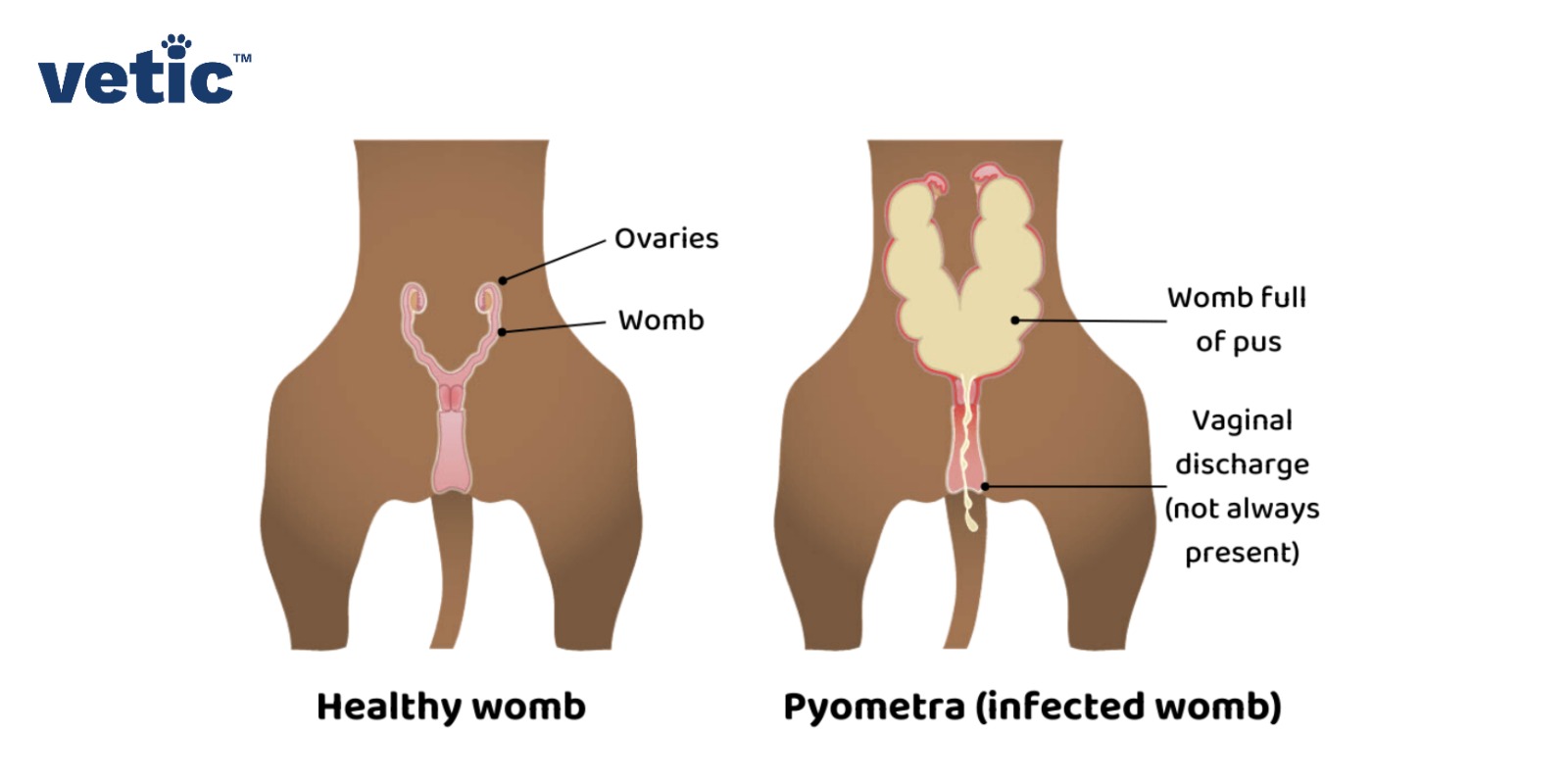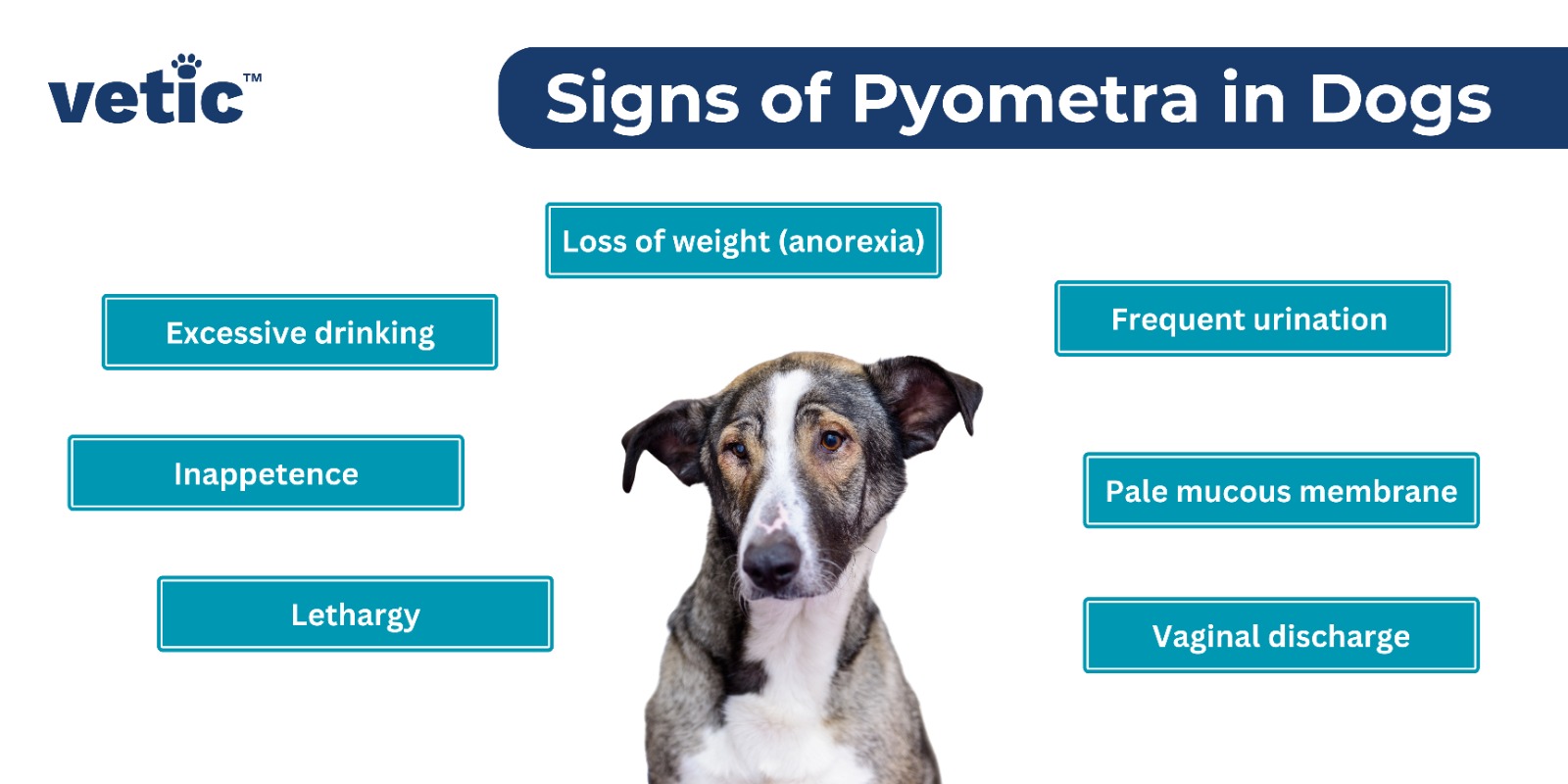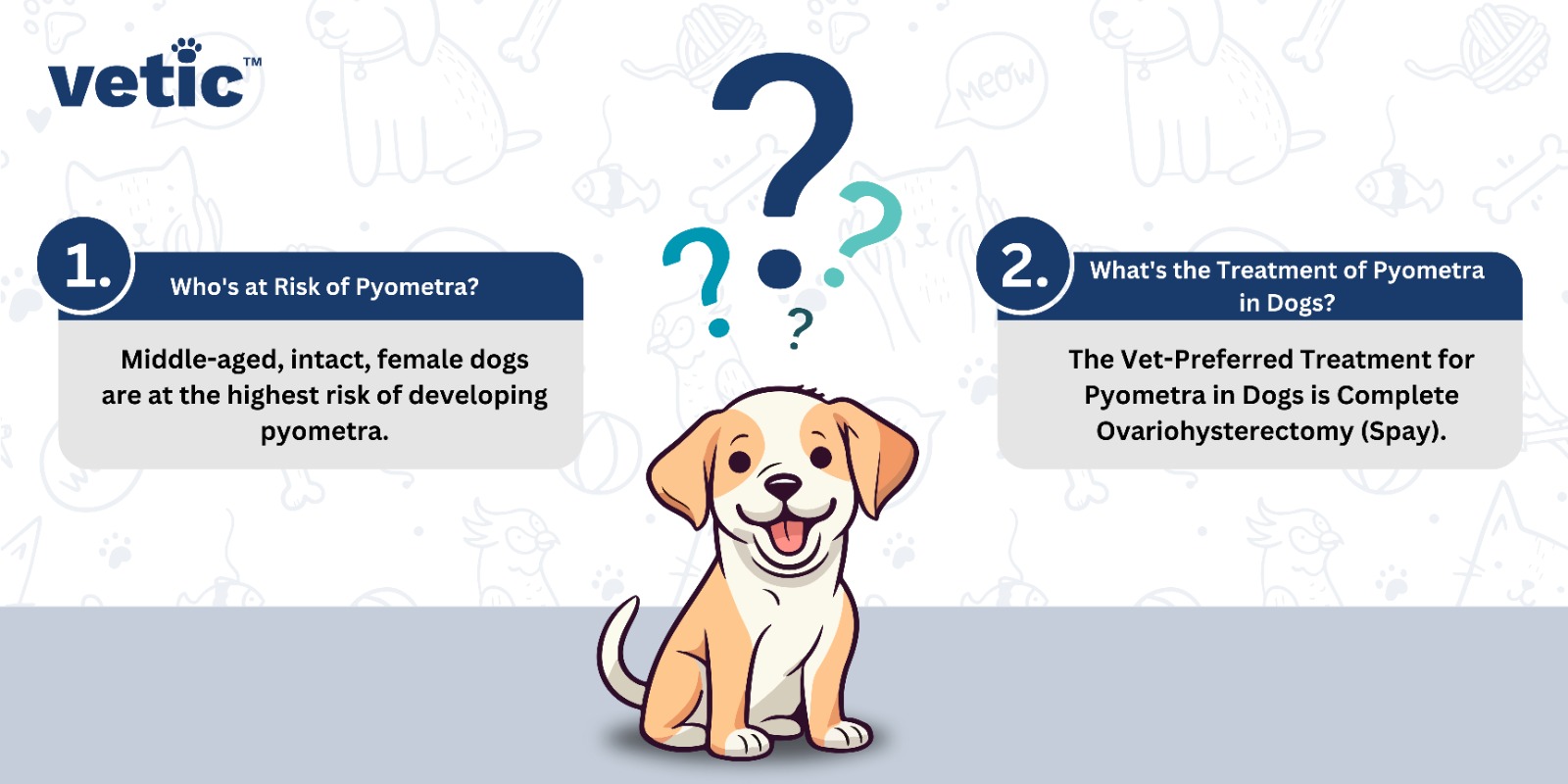What is Pyometra in Dogs?
Pyometra in dogs is a bacterial infection of the uterus or reproductive tract that leads to the formation of pus or pus containing discharge inside the uterus.
Pyometra occurs after the thickening of the uterine walls. This thickening follows a heat cycle and creates the perfect environment for the growth of bacteria inside the uterus.
Pyometra makes the dog’s uterine walls extremely fragile. During pyometra the pus and other toxins produced by the bacteria inside the uterus can leak into the blood causing the infection to spread throughout the dog’s body resulting in sepsis.
Without timely diagnosis and treatment, pyometra in dogs can be fatal.
What Causes Pyometra in Dogs?

Female dogs typically attain sexual maturity at the age of 6 months. Following their first heat at around the age of 6 months, they go into heat every 6 months.
Since each cycle can result in a potential pregnancy, the uterine walls thicken during a heat cycle to prepare for the reception of an embryo. Sometimes, the thickening is abnormally more and multiple cysts form inside the uterus.
Typically, multiple heat cycles without subsequent pregnancy can lead to bacteria travelling from the vagina to the uterus and their excessive growth thanks to the thickened uterine lining.
Although, pyometra in dogs is commonly seen among intact middle-aged female dogs, pyometra can occur in any dog who is at least 4-6 months old.
My Dog is Neutered, Can She Still Get Pyometra?
Complete ovariohysterectomy (spaying of dogs) at a young age should eliminate the risk of pyometra. However, incorrect surgical practices often result in remaining ovarian or uterine tissue inside the abdomen of the female dog.
Remnants of ovarian or uterine tissue after a spaying (neutering) surgery can result in stump pyometra in dogs.
What are the Signs of Pyometra?
In several cases, by the time the signs of pyometra in dogs become apparent, they are no longer limited to the reproductive tract.

The signs of pyometra in dogs often become systemic. These signs can include –
- Lethargy
- Inappetence
- Excessive drinking
- Loss of weight (anorexia)
- Frequent urination
- Pale gums (mucous membrane)
- Pus or bloody vaginal discharge
Diagnosing pyometra in its early stages is quite challenging because closed pyometra doesn’t produce any discharge from the vagina.
Only partially open or open pyometra produces discharge from the vagina.
Other symptoms are common for multiple diseases and infections. Therefore, it is impossible to tell if a dog has pyometra unless she is checked up by a veterinarian and she undergoes blood tests and radiography tests.
How is Pyometra Diagnosed?
Pyometra diagnosis involves physical checkup, blood tests and x-ray/USG.
Veterinary Check-up for Pyometra:
During physical checkup, the doctor observes the dog’s capillary refill time, vaginal discharge, activity levels, and weight loss.
Blood Tests for Pyometra in Dogs:
There are no specific blood tests for pyometra. A complete blood count can help the veterinarian see the levels of WBC, RBC, Haemoglobin and Platelet among other things. A high WBC count along with the involvement of globulins can be seen in pyometra.
Further tests of the liver function and kidney function of dogs with pyometra can reveal high values corresponding to liver and kidney damage.
Radiography Tests for Pyometra:
X-rays and USG will likely show an enlarged uterus. However, an enlarged uterus can also mean pregnancy, uterine torsion, hydrometra or cancer. Therefore, even with USG, your dog will require those blood tests and a thorough physical examination to confirm the diagnosis.
What is the Treatment of Pyometra in Dogs?

Depending on the state of health of the dog and the priorities of the pet parents, treatment can include either the complete removal of the ovaries and uterus. Or, medical management.
Surgery for Pyometra in Dogs
Surgical removal of the uterus and ovaries is preferred in the case of pyometra in dogs. It is the definitive treatment that removes the source of all hormones as well as the infected tissues.
Although both spaying and ovariohysterectomy after an infection of the uterine tissue are similar, the safe removal of the ovaries, uterus and other infected tissue without infecting the healthy tissue around these organs is quite challenging.
Therefore, it is imperative to control the infection with the help of oral or IV antibiotics and make up for any fluid loss before the surgery. Typically, veterinarians recommend medication for 7 to 14 days before the surgery.
Medical Management of Pyometra in Dogs
For pet parents who want to breed their female dog even after pyometra, medical management is one option. However, unless the breed of the dog is highly rare, it is not recommended by the vets for the health and wellbeing of the dog.
Medical treatment of pyometra has considerable short-term and long-term risk including breeding complications.
Is Your Dog At Risk of Developing Pyometra?
If your female dog has been spayed (neutered) properly, they have zero risk of developing pyometra.
In case, their ovary or parts of ovary or uterus were left behind during spaying, they have the risk of developing stump pyometra.
If your dog has undergone multiple heat cycles and she is middle-aged, she has a high risk of developing pyometra.
What is the Prognosis of Pyometra?
Early diagnosis, along with antibiotic treatment and complete ovariohysterectomy can improve the prognosis of pyometra in dogs.
However, if the dog has been suffering from pyometra for weeks and her RBC levels as well as WBC levels are low, they have a guarded to poor prognosis.
The prognosis for dogs with pyometra will also depend on other coexisting factors such as their liver and kidney diseases, and endotoxicity caused by the bacteria growing inside the uterus.
How Can You Prevent Pyometra in Dogs?
Early spaying (complete ovariohysterectomy) of female dogs can prevent pyometra.
Several sources report spaying dogs before their first season to reduce the risk of pyometra to zero.
However, the right age for spaying is variable according to different sources. You should speak to your veterinarian before your puppy is six months old for their reproductive health whether you want to breed them or not.
